IMPROVING TECHNIQUES AND FLOW IN FREE SPARRING
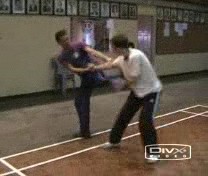
Reducing Speed and Punctuating Sparring For Better Combat Efficiency
As attacks come randomly in free sparring, can pre-arranged sequences be useful? While this is a sensible and logical question, it shows that the many kungfu practitioners, including some masters, who ask this question, have no experience of systematic combat training. In principle, it is similar to asking since traffic flow on real roads is never pre-arranged, or opponents in a football match can play in countless different ways, is it useful to practice driving using predetermined tasks (like turning right and going uphill) or practicing pre-arranged attacking and defending formations in football.
The answer in all these three cases, of course, is not only that such training is useful, it is necessary if one wishes to be proficient in driving, playing football or kungfu sparring. A failure to understand this philosophy is one major cause of the pathetic low level of kungfu sparring today. It is now an open secret that not only kungfu students but also instructors and even some masters cannot apply their kungfu techniques in sparring or fighting — even though some of them may be formidable fighters using techniques of other martial systems.
In our school, Shaolin Wahnam, there are a few methods to transform pre-arranged combat sequences to spontaneous free sparring. One such method is what we call Subtraction and Addition.
Sparring may be broadly classified into two categories — pre-arranged and free. For our training purposes, we classify Pre-Arranged Sparring into the following groups:
- Miscellaneous Techniques
- Combat Sequences
- Combination Sets
When we practice “Miscellaneous Techniques” (“san sau” in Cantonese pronunciation, also called “one-step sparring”) we perform a pre-chosen defence against a pre-chosen attack. When we practice “Combat Sequences” (“wooi hap tui ta”) we perform series of pre-arranged attacks and defences. When we practice “Combination Sets” (“tui chak”, called “two-man set” in some literature), we perform complete sets of pre-arranged attacks and defences.
Also for our training purposes, we differentiate Free Sparring into the following types:
- Conditioned Free Sparring
- Punctuated Free Sparring
- Unconditioned Free Sparring
In “Conditioned Free Sparring” (“thiew han san ta”), the movements are not pre-arranged but are abide by certain conditions, such as they must be only hand strikes, or must be chosen form specified combat sequences in certain order. In “Punctuated Free Sparring” (“cham chun san ta”), training partners purposely slow down or freeze their movements to allow their partners time to come out with appropriate responses. “Unconditioned Free Sparring” (“mo thiew san ta”) is what most people regard free sparring to be, without any conditions, except of course for such consideration like holding back force so as not to hurt the training partners.
Besides acting as source material for Shaolin Wahnam members to review what they have learnt or will learn in our Special Shaolin Kungfu Course, the video clips released in this series may help interested kungfu practitioners, irrespective of their styles, to have some glimpses of a sparring methodology that we have found to be very effective in enabling us to spar or fight using kungfu skills and techniques.
The video clips here are presented in the order of the time they were taken. They start with Grandmaster Wong giving instructions for the training session, and ending with course participants enjoying a chi flow. The progress of the participants can be seen in this half-hour training session itself. At the start of the session shown in the earlier video clips, the participants are slower and more hesitant in their free sparring. Towards the end as shown in the later video clips, the participants are fast, spontaneous and correct in their combative movements.
The result of this training session is shown in video clips of the next session of Unconditioned Free Sparring, which can be accessed here.
Slowing Down Sparring for Better Understanding

Some uninformed persons have complained that the sparring shown in some of our videos are slow. It is interesting that Grandmaster Wong asks the course participants to purposely slow down their sparring to enable them to have a better understanding of their techniques and skills. Then Grandmaster Wong explains the difference between technique-sparring and sequence-sparring. He explains how to modify or change a pattern in a sequence to suit the immediate situation, and then continue with the planned sequence.
Anticipating Opponents' Moves and Responding with Prepared Counters
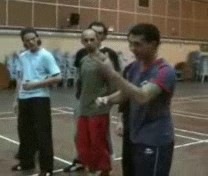
Davies from Shaolin Wahnam Scotland raises the question of the “guard-hand” and about counter-attacks from an opponent while implementing a planned sequence, and Ronny from Shaolin Wahnam Switzerland raises the question about surprised kicks from an opponent that may break the momentum of his planned sequence of attacks. Grandmaster Wong explains that when one spars at the technique level, he would hesitate to think what responses would be suitable, whereas when he spars at the sequence-level, he has anticipated possible defences or counter-attacks his opponent may make, and therefore he has already prepared for the appropriate responses.
Helping your Sparring Partner to Progress

Sifu Tim of Shaolin Wahnam England freezes in his attack for Hendrick of Shaolin Wahnam Germany to counter. Sifu Tim has also anticipated Hendrick's possible moves, and therefore can easily brush off Hendrick's kick and counters with another strike at Hendrick's throat. Although Hendrick could avoid Sifu Tim's attack by moving back, Sifu Tim advises that a better response is to “yield” or neutralize, deflect then counter strike. Sifu Tim repeats the attack for Hendrick to practice.
Purposely Slowing Down and Sparring Without Muscular Tension

Mark and Simon purposely spar in relatively slow movement and in a gentle, relaxed manner. Amongst other things, this enables their techniques to flow smoothly and see the mistakes they may have made. Indeed, this training is very beneficial to them. Just about half an hour later in an unconditioned free sparring session as shown in video clips found her, both Mark and Simon can spar spontaneously with force and speed, and without the mistakes they make in this video clip.
Freezing Attacks for Sparring Partner to Respond
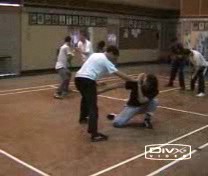
In this video clip Mark and Innes punctuate their free sparring at numerous places for the training partner to come up with a good response. For example, Innes grips Mark's arm. In a real fight, the exponent could have broken the opponent's arm and follow up with more attacks. But here Innes freezes for Mark to think of a suitable response.
Tempting an Opponent to Attack and Responding with a Surprised Kick
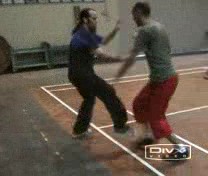
As they progress in their practice, the course participants become faster and smoother in their sparring, with less and less freezing. This naturally leads to unconditioned free sparring. The video clip shows Hubert learning a tactic from the sparring and applying it successfully. Having found Joshua like to move in vigorously to attack, Hubert feigns a retreat to tempt Joshua to move in, then he executes a surprised side-kick. As usual, laughter is a common feature in Shaolin Wahnam training.
The size of the video clip is 1.83 MB.
What would You do if your Kicking Leg is Caught?

Sifu Jordan of Shaolin Wahnam England who specializes in the Shaolin Five Animals is working out his Snake forms in this video clip against Davies of Shaolin Wahnam Scotland who specializes in the Tiger-Crane. They punctuate their sparring a few times to discuss on the best responses to use for various combat situations. What would you do if your leg is caught by your opponent while you kick him?
Learning from Mistakes in Friendly Sparring
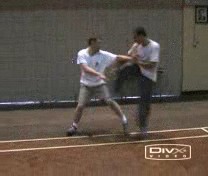
Chris who specializes in Dragon-Tiger is sparring with Ronny who specializes in Dragon Form. They use their specialized patterns quite well, and are able to defend some surprised kicks. Nevertheless both make some mistakes in this sparring session, as both have been hit a few times. They learn fast from this sparring session, as reflected by the fact that they are free from hits in the subsequent training session when they engage in unconditioned free sparring as shown in a subsequent video series. Learning from mistakes is an important aspect of training.
Exploiting an Advantage for a Decisive Strike

Jamie specializes in the Shaolin Five Animals, and Ronny specializes in the Dragon Form. Ronny makes a serious mistake in this training session, from which both benefit. Jamie exploits the advantage and swiftly moves in with a decisive strike, which may serious injure or kill the opponent in a real fight. This is a common occurrence, expressed in a kungfu tenet as “sau pat choong sum”, meaning that “the movements fail to follow the will”. Ronny learns from this mistake. In a subsequent training session of unconditioned free sparring they happen to partner again in free sparring but their skills are better. A few times Ronny is in similar combat situations but he never makes the same mistake.
Tiger-Claws and Throws
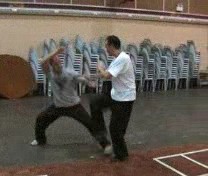
Sifu Tim and Simon try out some techniques from their specialized sets. Simon moves in swiftly with a successful strike at Sifu Tim's face. Sifu Tim evens up quickly with a kick to Simon's jaw. Both of them learn the appropriate defence quickly, which means that if an opponent attack them in a similar way the next time, they would be able to neutralize the attack.
A Snake, a Kick and another Snake
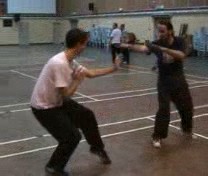
Joshua works on his Snake form in this video clip against Mark who specializes in Dragon-Tiger. An effective combination of techniques Joshua has adopted is a Snake jab, a kick followed with another Snake jab. Mark deflects the first Snake jab, and grips the kicking leg. What would you do when your kicking leg is held? Joshua follows with his second Snake jab as planned. Mark is hit and learns from his mistake. When Joshua applies the same combination again, Mark is able to counter all the three attacks.
A Spectacular Chi Flow after Free Sparring
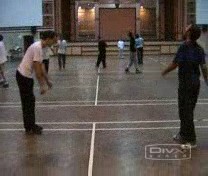
It is difficult for some people to believe the benefits from chi flow we experience in Shaolin Wahnam after sparring or any kungfu training. In the chi flow immediately after the free sparring shown in this video clip, some participants roll on the ground, some hit themselves, one crawl like an animal, while others sway like happy willows. Amongst other benefits, such chi flows enable the participants to cleanse injuries unwittingly sustained during sparring, to spar for hours without feeling tired, and to have more energy at the end of the training session than before it!
LINKS
Lessons from the Special Shaolin Kungfu Course of September 2005
- Part 1 - Initiating and Responding to Attacks
- Part 2 - Secrets in Counters against Boxer's Attacks
- Part 3 - Process of Composing a Kungfu Set
- Part 4 - Combat Sequences from Specialized Sets
- Part 5 - Refining Combat Sequences of Specialized Sets
- Part 6 - Making Variations to Meet Changing Combat Situations
- Part 7 - Bringing out the Beauty of Shaolin Kungfu in Combat
- Part 8 - From Pattern-Sets to Sequence-Sets
- Part 9 — Sparring at the Haphazard, Technique and Sequence Levels
- Part 10 — Improving Techniques and Flow in Free Sparring
- Part 11 — Free Sparring using Kungfu Skills and Techniques
- Part 12 — The Flowing Water Staff and its Application
